You are viewing the Cultures of Knowledge Blog archive for the ‘Events’ Category:
James Brown
July 17, 2012
Conferences and Workshops, Events, Podcasts, Project Updates
Tags: England, France, John Wallis, Martin Lister, Networks, Pierre Bayle, Pierre des Maizeaux
Convened by Philip Beeley and Martine Pécharman, the workshop is a letter-specific installment of the MFO’s ongoing series Across the Channel: Intellectual Relations between England and France in the Early Modern Period, and will feature epistolary talks from Antony McKenna (on Pierre Bayle), Anna Marie Roos (on Martin Lister), and Ann Thomson and Sébastien Drouin (on Pierre des Maizeaux). The workshop will be held at the Maison, and there’s no need to register; for further details, please visit the workshop webpage.
Kim McLean-Fiander
July 02, 2012
Events, Lectures, Podcasts, Project Updates, Publications
Tags: Cryptography, Editions, Elizabeth Stuart, Gender, Military History, Politics, Women
 Podcast available on the seminar page!
Podcast available on the seminar page!
Elizabeth Stuart, Queen of Bohemia (1596-1662) has often been portrayed as a romantic and frivolous figure; as a desperate, poverty-stricken, devout widow, or as a dilettante who spent her time going to ballets and masques and keeping the company of monkeys (which she allegedly enjoyed more than that of her children). A key constituent of these narratives has been the assumption that her political influence within Europe was negligible.
However, as Nadine Akkerman of Leiden University argued in her paper in our seminar series on 24 May (Opening up the Winter Queen’s Cabinet: The Correspondence of Elizabeth Stuart, Queen of Bohemia), this is a distorted and partial perception of the monarch that has largely arisen because historians have tended to overlook her vast correspondence. The fact is that Elizabeth’s nearly 1700 surviving letters from forty-seven archives in Europe and the US (estimated to be a mere 10% of what once existed) − which Nadine is editing for OUP − contain almost no information on her cultural life, and very little mention of plays, artists, or poets. They reveal instead that she was immersed in politics and was a keen follower of military affairs. Indeed, the underlying purpose of nearly all of her letters, Nadine argued, was to regain the lost Palatinate lands for her heirs.

Elizabeth, Queen of Bohemia
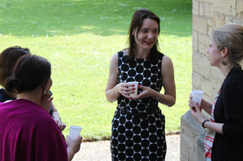
Nadine fields questions over drinks.
In a stimulating and wide-ranging analysis, Nadine discussed the often ignored, though politically important, roles of royal secretaries, scribes, and letter carriers. She traced the various ways by which Elizabeth attempted to outwit her brother Charles I’s surveillance of her correspondence (by using cryptography and steganography, for example), and suggested that Elizabeth used letters as a polite instrument by which to sabotage her brother’s plans for the Thirty Years War, thus making that event last ten years longer than it might otherwise have done. In sum, Nadine posited that an examination of this important though neglected correspondence should bring about an overdue reconfiguration of the Queen of Bohemia’s pivotal role in seventeenth-century diplomatic, military, and political history.
James Brown
June 12, 2012
Events, Lectures, Podcasts, Project Updates, Websites and Databases
Tags: Digitization, Editions, Electronic Enlightenment, France, Mapping the Republic of Letters, Networks, Text Mining, Visualization
 Podcast available on the seminar page!
Podcast available on the seminar page!
In the fourth paper of our seminar series on Thursday 17 May, Dr Glenn Roe – formerly of the University of Chicago, and current Mellon Fellow in Digital Humanities at Oxford’s OERC – gave a sophisticated and suggestive paper on ‘Text-Mining Electronic Enlightenment: Influence and Intertextuality in the Eighteenth-Century Republic of Letters’.
.
Building on his recent work with the Electronic Enlightenment corpus and other online repositories of long-form historical text, Glenn started his talk by observing the irony that the recent efflorescence of big data, culturomics, network analysis, and other quantitative approaches to culture – focusing in many cases on the macro interpretation of metadata over content – has authorized and promoted a convention of ‘not reading’ within the digital humanities, in which historical texts themselves can be marginalized or effaced altogether by the superabundance of information. The ready modelling of letters as a finite number of abstract datapoints (sender, recipient, and so on) and the vast quantities of diverse and often disorganized information exchanged within epistolary systems makes correspondence highly susceptible to such an approach.

Glenn during discussion.
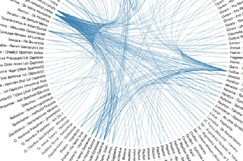
Visualizing influence.
As a supplement to this ‘distant’ reading, Glenn went on to demonstrate the potential of the latest machine-learning technologies to render significant volumes of transcription meaningful via text mining and the automated creation of patterns, frequencies, statistical models, and other forms of ‘mediated’ or ‘directed’ reading. Glenn distinguished between three kinds of text mining: predictive classification (used to generate new categories from unprocessed texts); comparative classification (used to correct and refine existing categories within processed texts); and similarity (used to measure broader similarities between documents and parts of documents, especially in terms of the identification of meaningful borrowing and instances of intertextuality). He then demonstrated each kind of approach within a rich series of examples drawn from his work with the ARTFL Encyclopédie Project, and most recently Electronic Enlightenment, before concluding his analysis by presenting – with caveats – some preliminary radial visualizations of textual influence generated using the D3 JavaScript library.
Philip Beeley
May 31, 2012
Events, Lectures, Project Updates
Tags: Astronomy, Editions, Europe, History of Science, Johannes Hevelius, Networks, Seventeenth Century, Theft
On 26 September 1679, while the astronomer Johannes Hevelius and his wife Elizabetha were spending a relaxing evening in gardens outside the gates of their home city of Danzig (Gdańsk), fire consumed their house in the old town. A large part of their possessions, books, personal manuscripts, and instruments, was destroyed; by the following morning the observatory which Hevelius had carefully erected on the roof of the house lay in ruins.
Much was irretrievably lost, but remarkably the letters he had exchanged with the learned men and women of Europe, including Kepler, Boulliau, Gassendi, Christiaan Huygens, Oldenburg, Wallis, and Kircher, together with his treasured collection of Kepler manuscripts, survived. At that time comprising thirteen volumes, the correspondence of Hevelius constitutes one of the great resources for the study and appreciation of early modern scientific networks.

Hevelius’s 45m focal-length telescope.
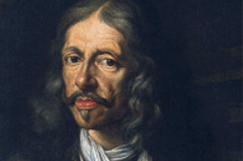
Johannes Hevelius.
Making this extraordinarily rich corpus available to the wider scholarly community is the task of a major collaborative editorial project currently underway in France, Germany, and Poland, of which I am pleased to be serving on the advisory committee. With most of the over 2,700 surviving letters now housed in collections at the BNF and the Bibliothèque de l’Observatoire in Paris, it was particularly fitting that the director of the French team Professor Chantal Grell (University of Versailles) – accompanied by Professor Robert Halleux (University of Liège) – should inform our third seminar series of the background and methodologies of this ambitious enterprise on Thursday 10 May. In a talk entitled ‘Editing the Correspondence of Johannes Hevelius: Networks, Themes, and Methodological Challenges’, Chantal first provided an overview of Hevelius’s life and letters, before giving a lively account of the complex archival afterlives of the astronomer’s epistolary collection following his death in 1687, including details of the letters famously purloined by Guillaume Libri in the mid-nineteenth century. Following a conspectus of Hevelius’s many correspondents, Chantal concluded with an analysis of the exemplary seventeenth-century scientific exchange between Hevelius and Pierre de Noyers, the secretary to the Queen of Poland. Following an interesting question and answer session – which included, inter alia, discussion of the benefits and challenges of balancing hard copy and digital outputs within large-scale correspondence projects – the evening came to fitting conclusion with a visit to the opening of the Renaissance in Astronomy exhibition at the Museum of the History of Science.
Seminars take place in the Faculty of History on George Street on Thursdays at 3pm. For future talks in the series, please see the seminar webpage. All are welcome!
The neglected theme of epistolary archives – the active collection and curation of letter objects and related papers within various social and institutional ecosystems over broad expanses of time – is close to the heart of Cultures of Knowledge, so we’re delighted to see that friends and colleagues at the Centre for Editing Lives and Letters at QMUL are organizing a fascinating-sounding anniversary conference on The Permissive Archive. To be held at CELL in November 2012, the conference ‘seeks presentations from a wide range of work which opens up archives – not only by bringing to light objects and texts that have lain hidden, but by demystifying and demonstrating the skills needed to make new histories’. Aiming to rescue archives from their persistent but wildly misleading association with neutrality, inertia, and ‘settled dust’, the conference invites proposals (which should cover the period 1500-1800) on definitions of permissive archives; the shape of the archive – ideology and interpretation; the archive which challenges or disrupts; dispersed collections; the archivist and the historian; the ethics and comedy of the archive; order and anarchy; and many more exciting topics.
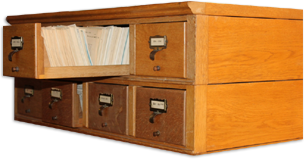 The deadline for 300-word proposals for 25 minute papers is 31 July 2012. For full details and submission instructions, head along to the conference webpage.
The deadline for 300-word proposals for 25 minute papers is 31 July 2012. For full details and submission instructions, head along to the conference webpage.
James Brown
May 25, 2012
Events, Lectures, Podcasts, Project Updates
Tags: Animals, Conrad Gessner, Felix Platter, History of Science, Illustration, Natural History, Networks, Sixteenth Century
 Podcast available on the seminar page!
Podcast available on the seminar page!
 The zoological theme continued on Thursday 3 May when Florike Egmond from Leiden University (formerly of the Clusius Project) gave a talk in our seminar series entitled The Webs of Clusius and Gessner: Correspondence, Images, and Collecting in Sixteenth-Century Natural History. In a detailed and lavishly illustrated discussion, Florike described her recent discovery of two albums of original watercolour drawings created for the sixteenth-century Swiss naturalist Conrad Gessner (1551-1558) within the Special Collections of the University of Amsterdam.
The zoological theme continued on Thursday 3 May when Florike Egmond from Leiden University (formerly of the Clusius Project) gave a talk in our seminar series entitled The Webs of Clusius and Gessner: Correspondence, Images, and Collecting in Sixteenth-Century Natural History. In a detailed and lavishly illustrated discussion, Florike described her recent discovery of two albums of original watercolour drawings created for the sixteenth-century Swiss naturalist Conrad Gessner (1551-1558) within the Special Collections of the University of Amsterdam.
Crafted in Basel by the anatomist and natural historian (and Gessner’s friend) Felix Platter (1536-1614), the images – of a menagerie of marine life, mammals, reptiles, and amphibians, across 369 pages – formed the basis of many of the illustrations within Gessner’s zoological masterwork, the Historiae Animalium (1551-1558). You can find out more about this exciting discovery in Florike’s recent blog post for the Picturing Science network, and in her recent article for the Journal of the History of Collections.
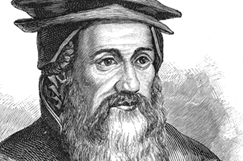
Conrad Gessner.
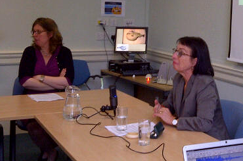
Anna Marie chairs Florike.
Renaissance correspondence networks, argued Florike, played a key role in sharing and disseminating (although not, curiously, in facilitating discussion of) manuscript images, as both Gessner, Clusius, and other naturalists solicited hand-drawn illustrations of animals to serve as the basis of woodcuts in their publications from colleagues and agents around the world. These exchanges, in turn, formed the basis of what Florike termed (with caveats) a kind of visual ‘canon formation’ within natural history, as elements of various portrayals were adapted, reworked, and reappropriated across different contexts and between media; as representational norms stabilized; and as the repertoire of animals deemed suitable for inclusion in zoological texts (whose wide remit originally encompassed familiar creatures such as cats and goats) was narrowed and standardized. A lively question and answer session focused on the artisanal communities responsible for producing the illustrations; how the works were commissioned and stored; and the frustrating but typical absence of any kind of discussion of manuscript images in the letters with which they circulated (resulting, suggested Florike, from the self-evident nature of enclosed materials).
Seminars take place in the Faculty of History on George Street on Thursdays at 3pm. For future talks in the series – and to listen to the podcast of Florike’s paper – please see the seminar webpage. All are welcome!
Update: Podcasts now available!



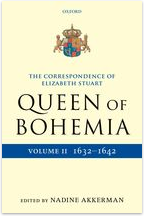




 The deadline for 300-word proposals for 25 minute papers is 31 July 2012. For full details and submission instructions, head along to the
The deadline for 300-word proposals for 25 minute papers is 31 July 2012. For full details and submission instructions, head along to the  The
The 


 Join
Join 